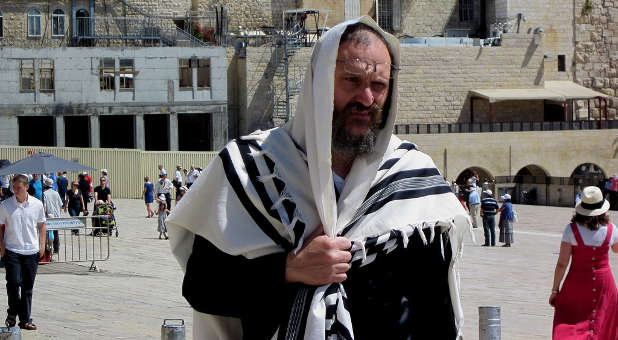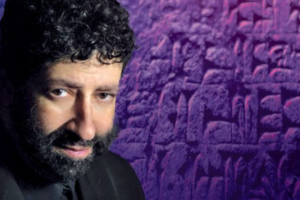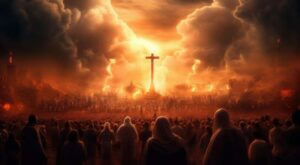As a Jewish boy growing up in the 1950s, it was always exciting to me to think about wearing the tallit. This is because in order to wear the tallit, you had to have had your bar mitzvah.
For years, you would study Hebrew and Jewish history, and Jewish customs and traditions. Then on the day of your bar mitzvah, you would wear a special new tallit and read from the Torah (the five books of Moses, which are the first five books in the Old Testament) and the haftarah (a series of selections from the books of the prophets, called the Nevi’im). You would also give a d’rash (exposition or exegesis) on the Torah reading, and then end with reading a letter of thanks to the rabbi, cantor, and board of the synagogue. The tallit you received at your bar mitzvah would be worn throughout your life for all the major life events. It would then be passed on to your son in your memory when your life here on this Earth ended.
To a Jewish person, the tallit is symbolic of one’s Jewish identity because it is used in every major life cycle event. But to those not born Jewish, it is symbolic of the Jewish Messiah. More and more, as I travel to speak in churches, I meet people who are seeking to understand the Jewish roots of the Christian faith. They will blow the shofar, pray the Shema, and don a tallit during prayer. At the synagogue I lead, we keep tallitot (the plural form of tallit) for guests to use during the service, and many are eager to do so. Coming under the tallit often helps a person seek Yeshua without distraction and commune with the Ruach HaKodesh (Spirit of God) in a whole new way.
I do not believe that as followers of Yeshua we are obligated to pray under a tallit, but I have heard many people say that coming under a tallit in prayer helped them deepen their intimacy with Hashem. The tallit does not have special power in itself, but it reminds us of God and His Word, in which we find all power.
So if the tallit can be this significant in a person’s relationship with God, you may be wondering: “What exactly is it and how is it used?”
The tallit is the Jewish prayer shawl. It is rectangular and generally white with blue or black stripes, and it has tassels on each of its four corners called tzitzit. The tallit can be large (tallit gadol) and cover a person’s entire body, or it can be small (tallit katan), reaching only to the shoulders. But it must be long enough to be worn over the shoulders as a shawl and not just around the neck as a scarf. For a Jewish person, it is typically used in every major life cycle event—from circumcision to bar/bat mitzvah to marriage and even death. But it is most frequently used in prayer.
Tallitot are generally worn at morning Shabbat services and during morning prayers. An exception is the Kol Nidre, the evening service on the eve of Yom Kippur (Day of Atonement), during which the tallit is also worn. A person wearing a tallit will generally keep it draped over his shoulders, but during times of prayer he will use it to cover his head.
Traditionally men have worn the prayer shawl because Jewish law did not obligate women to wear them and the Torah discourages women from wearing men’s garments. But now there are many styles and colors available that are very feminine, so both men and women wear tallitot. The stripes on the tallit are usually blue, black or purple, but they can be any color of the rainbow. The tallit is classically made of wool, cotton or silk, but it can be made out of any material so long as the prohibition against combining linen and wool is observed.
The wearing of the tallit commences in the Torah. We read in the 15th chapter of the Book of Bamidbar (Numbers):
“Adonai spoke to Moses saying, “Speak to Bnei-Yisrael. Say to them that they are to make for themselves tzitzit [fringes, ציצית] on the corners of their garments throughout their generations, and they are to put a blue cord on each tzitzit. It will be your own tzitzit—so whenever you look at them, you will remember all the mitzvot [commandments] of Adonai and do them and not go spying out after your own hearts and your own eyes, prostituting yourselves. This way you will remember and obey all My mitzvot and you will be holy to your God. I am Adonai your God. I brought you out of the land of Egypt to be your God. I am Adonai your God.” (Num. 15:37–41, TLV).
In ancient times, people in most cultures wore some type of blanket-like garment to protect them from the sun during the day and the cool air at night. So the command in Numbers 15 was not for the Jewish people to start wearing this type of garment but rather for them to add the tzitzit on the four corners, which would set them apart from other nations. Even today, Bedouins wear abayas, which can resemble the tallit but lack the tzitzit.
The purpose of the tallit was, in fact, to hold the tzitzitot, or fringes. The tzitzitot were to be tied on each of the garment’s four corners so that when we look at the tallit, specifically the tzitzit, we would remember the commandments of God. Today there are T-shirts onto which the tzitzit may be tied at each of the four corners, illustrating again that the tzitzit are most important.
Traditionally on each tzitzit is a blue cord called the tekhelet. According to some, the blue tekhelet is to remind us of God’s creation, the ocean, the sky, the tablets upon which the Ten Commandments were written and His throne of glory. This particular color blue was once very hard to acquire and was thus used on special garments.
During antiquity, it was derived from a type of snail found near the Aegean Sea. It has been thought that after the destruction of the second temple, knowledge of the actual source of the dye was lost. For this reason, it is now common for the tzitzit to have only white fringes. It is believed that some of the species that carry the dye have been found, but that is not universally accepted as fact.
There are places in Israel today where you can purchase the tzitzit with the tekhelet. They can be tied on to the four corners of a garment to make a tallit. During one of the tours of Israel that my wife, Racquel, and I co-led with two other rabbis over twenty years ago, we met an Israeli storeowner who sold the tzitzit with the tekhelet.
I purchased a tallit gadol (large tallit) and a tallit katan from him, and I still wear them today. There are also many websites that sell tallitot, some of which include the tekhelet. To learn more about how to purchase a tallit, you can visit our website at www.GesherInternational.com. {eoa}
Excerpted from The Tallit: Experience the Mysteries of the Prayer Shawl and Other Hidden Treasures, by Charlie Kluge (Charisma House, 2016).
See an error in this article?
To contact us or to submit an article





















